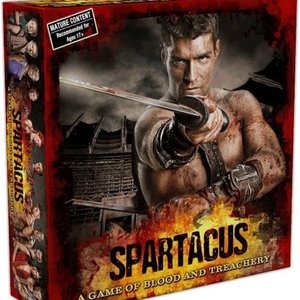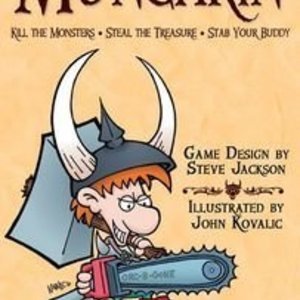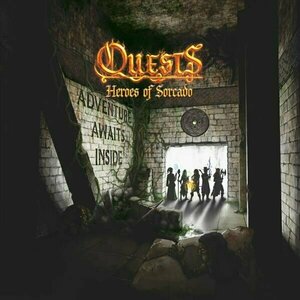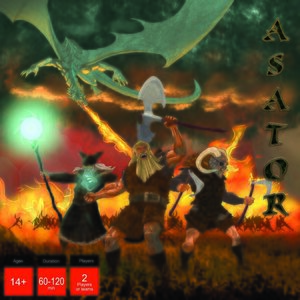Josh Burns (166 KP) rated Spartacus: A Game of Blood and Treachery in Tabletop Games
Jun 20, 2019
The base game is 3-4 players, there are expansions that increase that, but I'm sticking with the base game for this review. Each player controls a different House, which have their own stats, abilities, and alternate objectives, with the main objective being to reach 10 influence.
The game plays basically as follows:
Upkeep phase: collect money, try to heal wounded gladiators, and reactivate slaves that were used.
Market: A number of cards are drawn and placed face down, then one card is flipped. It could be a gladiator, a slave (can earn you money and may have abilities that are useful outside the arena) or gear for your gladiators. All players choose how many coins to bid and keep them in a closed fist until everyone is ready, then everyone reveals their bid. Whoever was highest wins. You then repeat till each card is flipped. You can also put your own cards up for auction or offer trades.
the arena: after this, 2 players chosen by another player have to either fight each other, pitting a slave or gladiator against the oppents, or forfeit at the cost of Influence. Players may place bets on who will win and if the loser will be killed, or badly injured.
The game is basically 2 games in 1: outside the arena and in it.
Outside: It is primarily about making deals, lying, setting each other up, making temporary allies and backstabbing. Literally the only rule in the actual rulebook about how to go about this is: "Don't be a dick. " It actually says that, and says they mean keep it fun, don't actually try to be a spiteful douche. There is nothing directing you when to lie or be honest, if you have to keep promises, etc.
In the arena: Combat is fun and simple. Not all fighters are equal but I have seen weak ones overcome the odds. If you're a fan of the show you will recognize many names. As a quick sidenote, an expansion can turn these fights from 1 vs 1 to 2 vs 2. I've won hard fought games, and I've lost on purpose to win a bet or fulfill a deal. Your fighter may or may not die or be injured. The player who chose the participants also decides the fate of the losing fighter (if they didn't die fighting) with a thumbs up or down. The player with the losing fighter can plead for the fighters survival or bribe, or maybe the player chosing wants the losing player to owe them a favor. There is never a clear cut choice.
In conclusion: This is a favorite of mine. It is unbelievably fun making deals (whether you keep them or not) bribing, setting players against each other etc. The combat is fun and easy to learn and the other players are typically screaming at whoever they want to win if they aren't doing well (in good fun, not actual anger). I can't think of anything to not like about it. If you like the show you'll love references such as the "Jupiter's Cock" card and seeing all the characters (slaves, gladiators, and dominas). If you don't like the show, it's still a hell of a game and you don't need to watch the show to know what's going on.
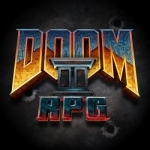
DOOM II RPG
Games and Entertainment
App
Hell has returned! Prepare yourself for DOOM II RPG for the iPhone, the sequel to id Software’s...
Purple Phoenix Games (2266 KP) rated Munchkin in Tabletop Games
Jan 6, 2020
In Munchkin games, you are trying to become the first player to reach 10th Level. That’s the goal. You take on the persona of a 1st Level basic human (no Starbucks jokes please) who will be adventuring with a party of your opponents through a dungeon. You will be kicking down doors, fighting monsters, placing curses on your fellow party members, and buffing yourself with cards featuring funny art and punny references. Your party mates are also trying to achieve 10th Level and will do everything they can to block your progress, so be prepared!
DISCLAIMER: This review is not for a specific game within the Munchkin universe, but for the system as a whole. All Munchkin games will pretty much use similar, if not exactly the same, rules to play the game with minor variations and different theming. I will be using The Good, The Bad, and The Munchkin for my review as it is one of the two versions I still own of the franchise. Also, I will not be detailing every rule in the book(s), but giving a brief overview of how the game plays. -T
Setup is easy: shuffle the deck of Door cards and the deck of Treasure cards. Deal cards to the players for their opening hands and keep the included die handy.
Your turn consists of just a few phases: Open a Door, Look for Trouble, Loot the Room, and Charity. To Open a Door, flip over the top card of the Door deck. If it is a monster you must fight it or run. If not a monster, you can move on to the next phase. If it IS a monster, prepare for combat. Combat is simple in that you add up all your bonuses from your gear cards you have attached to your character and try to beat the strength of the monster. Your party mates can screw with you during combat by adding strength to the monster or adding monsters to the fight to make it a more difficult encounter. If you win, you gain a Level on the spot. Some monsters are worth even more than one Level. If you did not encounter a monster, you will add the non-monster card you drew to your hand and you may Look for Trouble by playing a monster card from your hand to initiate a combat. This fight will work the same way and you will be susceptible to pile-ons as before. You may Loot the Room if you defeated a monster on your turn by drawing Treasure cards equal to the printed reward on the bottom of the monster card you defeated. If you defeated the monster yourself, unaided, these are drawn in secret. If you were given help by your mates then you may have to split up the loot per any agreements made. These cards are usually very advantageous to you so they are usually very valuable to others as they attempt to steal away your goods. If you did not fight a monster yet this turn, you may draw another secret card from the Door deck to add to your hand. Should your hand size climb above your limit (dictated by your Race card, if any) you will slide into the Charity phase to relieve your hand of extra cards. Give all excess cards to the player of lowest Level, or split them among those that share the lowest Level. It is now the next player’s turn and you continue play until someone reaches 10th Level.
Components. It’s a bunch of cards and one die. The cards are of okay quality. Nothing to write home about. The die is nice with one of the faces having the Munchkin logo head imprinted on it. It will also have a color scheme that matches the version of Munchkin you are playing, so it’s easy to match them back up if they become integrated with each other. Overall, the components are fine, but not wonderful. That’s probably why these are pretty inexpensive to purchase.
Okay, so like I said earlier the original vanilla Munchkin was the first hobby board game I ever purchased. My friends and family had no idea hobby games existed, so there was actually a pretty steep learning curve for us. Once we figured it out, however, we began to play it a ton and really love it! The cards are cute, the game play is pretty easy if you have played hobby games before, and the puns kept us rolling for a good while. There was a time when I owned every version of Munchkin in circulation and we never even played half of them. Seeing this I got rid of them through BGG Auctions. I have The Good, The Bad, and The Munchkin and Munchkin Zombies right now and I feel that will be plenty for me from here on out – unless they make a Doctor Who or Firefly set or something /*checks warehouse23 to find out if these are available/.
Do I still love Munchkin? No, not really. I LIKE it, but I don’t really want to play it all the time any more. Why? Well, as my gamer experience increases and I level up, my game tastes also level up. I see why people enjoy and even love this game system. I myself loved it for a time. But there are better games out there that accomplish the same feelings without being as sophomoric and have better choices to be made. Will I still play these games? Heck yeah! If someone asks to play a Munchkin game I am all in. I have different tastes and preferences now, but I’m no snob. Just come prepared, because I won’t go easy on you.
We at Purple Phoenix Games give this family of titles a backstabby 16 / 24.
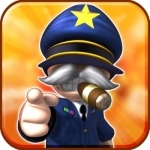
Great Big War Game
Games and Entertainment
App
▶ GAME OF THE YEAR, WINNER !! (Mobile category, Game Dynamo 2012) ▶ STRATEGY GAME OF THE YEAR,...
Purple Phoenix Games (2266 KP) rated Quests: Heroes of Sorcado in Tabletop Games
May 26, 2021
Disclaimer: For this preview, we were provided with a Tabletop Simulator file for the demo/prequel adventure. These are not the final components, since it is a digital file, but the artwork and rulebook are mostly finalized – so the gameplay is what you will get in the physical copies of the game. -L
Quests: Heroes of Sorcado is a cooperative, campaign-driven game in which 1-6 players will take on the roles of party members with the goal of completing all 8 of the included adventures. The game does come with a tutorial/prequel adventure to help introduce players to the mechanics and overall gameplay before diving in to the full game. To setup for this Adventure Zero, place the game board within reach of all players, set aside the Campaign and Adventure books, place the Boss card for this adventure face-down above the board, and sort and place Potion/Loot/Armor/Health tokens in their corresponding areas. Set the 6 required Adventurers for the prequel in a circle near the game board, and take the listed Health and Starting Equipment for each Adventurer. The prequel uses only a single Location, so set that Deck in one of the Location spaces of the board, and the game is now ready to begin!
Depending on the player count, everyone will take on the role of at least one of the Adventurers, and the game itself is wholly cooperative. Here is how Adventure Zero works. Each Adventurer, in clockwise order, will be dealt 1 face-down Location card. Then, starting from the first dealt Location card, the Adventurers will take turns revealing their card. Some cards are Events or Story Moments, and prompt players to read from the Adventure/Campaign books. These cards often describe a scenario and require the player to select one of several provided choices, either earning a reward or penalizing the group. Most cards are Monster cards and will begin a combat! Each of the Adventurers has varying values for the four Stats of the game: Strength, Intelligence, Dexterity, and Wisdom. Combat in the game involves rolling a d20 and adding the appropriate Stat modifiers to the roll. You can also use Potions and Equipment to buff your rolls as well. How do you determine success or failure? Every Monster has a weakness to a specific Stat, so you will use that Stat modifier to enhance your rolls. Equal or exceed the Monster’s weakness, and it is defeated! Depending on the difficulty/level of the Monster, you will either fight with 2-6 Adventurers – adding their modifiers and abilities to your roll as well. How you setup your Adventurers is important, as adjacency is what helps determine who can be in each combat. If you defeat a Monster, collect the reward (Loot tokens, Potions, or Treasure cards), and the game continues to the next player. If you lose the fight, the Monster moves to the next Adventurer and combat begins anew. Once every Location card has been revealed and resolved, the Adventurers will reveal the Boss card and the final combat begins! Even though each combat has one primary Adventurer/player at the helm, the game is cooperative, so make sure you’ve got that teamwork mentality!
I have to say that I was pleasantly surprised by Quests: Heroes of Sorcado. The gameplay may seem a bit involved at first, but it actually flows pretty seamlessly and effortlessly. As someone who has played a handful of other campaign-driven board games before, I have to say that this one was by far the easiest for me to learn and play. Resolve Location cards, beat Monsters, and (hopefully) defeat the final Boss. Pretty straight-forward, and I really appreciate that. One thing that helps make it so user-friendly is that the game is based on only 4 Stats, instead of every conceivable Stat used in other role-playing games. That helps keep the game uncomplicated, while still offering players options every turn. Another thing that I really like? The Campaign/Adventure books are pre-written stories, prompts, and scenarios that allow the game to be truly cooperative. No need for an all-knowing Game Master here, as everything is already laid out for you. I also really like these pre-written aspects because it helps deliver the role-playing feel without pressuring the players to create their own campaign. Yes, there are still some ‘choose your adventure’ elements to it, but it doesn’t give so many options to overwhelm players.
That being said, I do have to mention that this is a campaign-driven game, so you will know the main storyline after your first complete playthrough. Although you would know the Monsters/Events/Boss/etc. of each adventure, the shuffle and draw of the decks would allow for variability, and thus replayability. You know the all the twists in the story, but will be able to play with different hero combinations as well! All 8 adventures will take quite some time to complete though, so don’t let the fact that you’ll know the main storyline after one playthrough turn you off from the game completely! Normally, I like to talk about the components of a game. Since this was a Tabletop Simulator version of the game, I am unable to really do so. I will commend the artwork and style of the game though – it is very thematic, engaging, colorful, and fun to look at. The text and abilities are clear, I love the color-coded modifiers, and the cards are all pretty intuitive. I have no doubts that the physical copies of the game will be quality productions as well.
As I stated above, this preview only covers the demo/prequel adventure, and its real purpose is to introduce players to the gameplay. That being said, I know that the full adventures will offer players additional elements (Side Quests, trading Loot and Potions, ‘level up’ the Adventurers, etc.) that will just add to the experience. Yes, there is the ‘one and done’ aspect of a campaign-driven game, but there is so much content in the full game to keep you going for quite a long time. If you’re looking at getting into this genre of game, but are worried about complexity, I would highly recommend Quests: Heroes of Sorcado. The gameplay overall is simple and straight-forward, while still offering the epic campaign feel. This one hits Kickstarter today, so head on over and check it out for yourself!
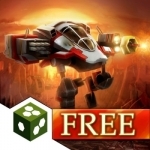
Hex Mechs Free
Games and Entertainment
App
In the year 2523, a large wormhole opened up on the outer limits of Jupiter's orbit. E-CON's Navy...
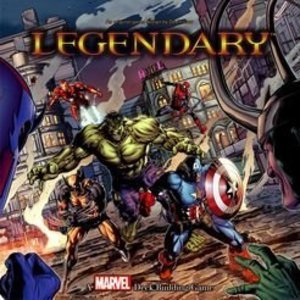
Legendary: A Marvel Deck Building Game
Tabletop Game
Legendary: A Marvel Deck Building Game is set in the Marvel Comics universe. To set up the game,...

Thirty Days & Seven Seas – Pirate Battle Board Game Starring Clarence, Jeff and Sumo
Games and Entertainment
App
From the creators of "Monsters Ate My Birthday Cake"... Ahoy, mateys! Join Clarence and friends on...
Purple Phoenix Games (2266 KP) rated Asator in Tabletop Games
Oct 20, 2020
Asator is a head to head (or teams) game of troop maneuvering and attacking using 30 identical miniatures on each side. Each mini acts as a platoon of three different kinds of armies, plus a Chieftan, Master, Wizard, and Dragon that all have different special abilities. The winner of Asator is the player who can eliminate their opponent’s leadership (Chieftan, Master, and Wizard).
DISCLAIMER: We were provided a prototype copy of this game for the purposes of this review. These are preview copy components, and I know that the final components will be slightly different from these shown. Also, it is not my intention to detail every rule in the game, as there are just too many. You are invited to download the rulebook, back the game through the Kickstarter campaign, or through any retailers stocking it after fulfillment. -T
To setup, place the battle mat on the table, and then players will place groups of minis on the field within the closest three rows of hexes in alternating turn fashion. Players will also take the two large Battle Sheets and a dry-erase marker to keep track of every one of their minis’ stats throughout the game. Each player will also choose five of the given 10 Wizard spell cards to use for the game, and each spell may only be used once during the game. Once all army minis are placed, the first player will move up to 20 units on the battlefield and attack opponent armies if possible. The game is now on and decimation is the goal.
Each mini type corresponds to a different group of armies, plus the dragon and three leader pieces. All armies of the same type have the same stats for movement, hit points (HP), armor rating (AR), and attack weapons. Also each mini is labeled on the bottom so keeping track of each unit is made a little easier. Obviously the leader pieces are more powerful and each has a special style of combat. The Master wields an axe and shield (which is broken after one hit) to increase AR and dole out the damage. The Chieftan wields a spear, twin axes, a bow, and a shield. Similar to the Master, the Chieftan’s shield is broken after an attack against him, and his spear is broken after a missed attack. The Wizard is not at all strong in melee, but has powerful spells at his disposal to be used for the disposal of enemy units.
Besides the leadership trio each side also brings a Dragon to the battle. Dragons can move slowly by land, but quite quickly by air. Once in the air he or she may deliver a Fire Blast that causes huge damage, but then the Dragon must ground themselves to regain stamina for flight. In addition, each player will have access to Cavalry, Infantry, and Bowmen, each with their own stat blocks and abilities.
This is all well and good, and is somewhat similar to the strategy one would use in Chess. Combat, however, is much more involved than that of simply moving into an enemy’s space and automatically overtaking it. In Asator combat victory is decided via a VERY pared down version of D&D combat. It uses a simplified d20-based attack versus the enemy Armor Rating (AR). Rolls over the AR of the enemy is a success and damage is dealt. Done. Some attacks require a roll of 2d6 for damage amount, like spells and Dragon attacks. That said, combat is decided using 1d20 and 2d6. That’s it.
The game continues in turns where the first player will move their pieces and attack, and then the next player will do the same until one player has defeated all three enemy leaders and earned the title of Asator – Master of War.
Components. Again, we were provided a prototype copy of the game, but most of the components are what will be received when the game is backed or purchased. That said, the game utilizes a cloth battle mat that folds into the box, four dry-erase Battle Sheets, two dry-erase markers, dice for both players, Wizard spell cards for both players, and 60 miniatures. The battle mat is great fabric quality with minimal art that doesn’t get in the way of play (much appreciated). The dry-erase components are good. The card quality is fine. The dice are black and white dice to correspond with players using the black or white minis, and are of normal quality. The minis are great and I enjoyed playing with them.
Now for the negatives of what is included in the box. First, the art. Now, there is very minimal art used throughout the game. It’s just not a focal point, and it shows in the game’s production. I found the sketch on the cover of the rule book (which is the same as the watermark on the Battle Mat) to be very cool, but the box cover art leaves some to be desired. Similarly, the Wizard spell cards use very generic-looking art icons with text for explanation. I am most certainly being hyper-critical here because flashy art on these components are certainly not needed to play or highly enjoy the game. For my tastes, though, I would like to see more polished art on these pieces as the art is so sparse throughout.
But how does the game feel? It’s truly quite good. I don’t play many wargames or 1v1 skirmish style games, so to present me with something like this and for me to enjoy it as much as I have has to be a sign of something good. Again, I am no strategic war general, but being able to employ different strategies every game is exciting. Testing out the different combinations of Wizard spell cards is fun for a tinkerer. And, of course, playing with a bunch of minis is always good fun.
There is a good game here, and I absolutely love the combination of Chess maneuverability with the simplified RPG d20 battle system. It works well in a game like this where each piece owns a stat block of which players will need to be mindful. I didn’t quite mention my favorite part of the rules yet either: natural 20 on a combat roll equals insta-death. Yes, even to the Dragon, which happened in my very first game. THAT is a cool rule that tripped up tactics quite often in my plays.
All in all this game is a great example of combining a couple sets of mechanics that wouldn’t be expected and creating a great gaming experience from them. I invite you to back the game on Kickstarter when it goes live if you are looking for that special game that is unlike many others you currently own. If the art were spruced up a bit I would be fawning all over it, but even without impressive art I still find I have the twitch in my brain to play it again and again. I wonder how many natural 20s I can roll in a game. Great, now I want to set it up and see…
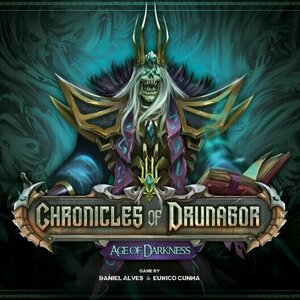
Chronicles of Drunagor: Age of Darkness
Tabletop Game
Daren has always been a land mired in conflict – from the moment the Mortal Races met in its...
